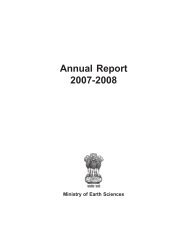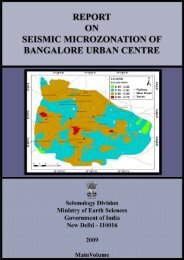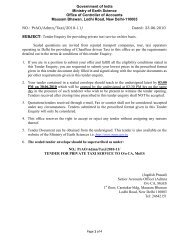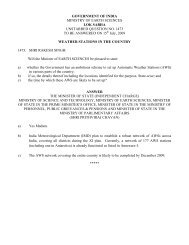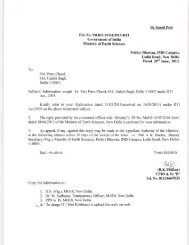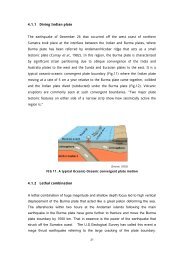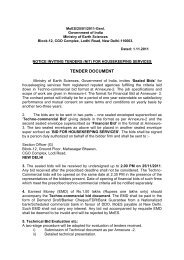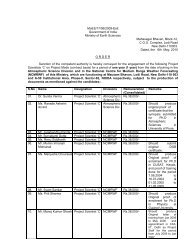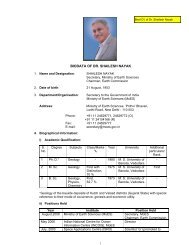Annual Report 2009-2010 - Ministry Of Earth Sciences
Annual Report 2009-2010 - Ministry Of Earth Sciences
Annual Report 2009-2010 - Ministry Of Earth Sciences
Create successful ePaper yourself
Turn your PDF publications into a flip-book with our unique Google optimized e-Paper software.
Six among the 17-ensemble runs of QUMP<br />
experiment are found to be reproducing mean<br />
summer monsoon climate reasonably well<br />
and these fields are used to drive the Regional<br />
Climate Model (RCM)-PRECIS to generate 50<br />
km grid scale under A1B Scenario (Medium<br />
Emissions) runs over South Asia continuously<br />
for the period 1961-2100.<br />
The three-member ensemble runs of RCM-<br />
PRESIS are completed and the results are<br />
under critical evaluation and the simulations<br />
in respect of the remaining 3-ensemble QUMP<br />
members are currently underway. The results of<br />
this RCM monsoon climate response are critical<br />
components of the India’s National Climate<br />
Change Assessment (INCCA) programme of the<br />
<strong>Ministry</strong> of Environment and Forests (MoEF)<br />
for generating various sectoral impacts due<br />
to such projected changes of future monsoon<br />
climate.<br />
• A framework of three regional climate models<br />
(PRECIS, WRF and Reg CM) is currently built<br />
to examine the following spatial characteristics<br />
associated with the summer monsoon in<br />
coming decades up to 30-50 years.<br />
a) To quantify future climate scenarios for<br />
India under different emission scenarios<br />
as well as “committed climate change”<br />
scenarios, during the 21 st Century including<br />
various intermediate time slices<br />
b) To develop ensembles of regional<br />
climate change scenarios and to quantify<br />
uncertainties.<br />
c) To examine the nature of possible changes<br />
in the frequency and intensity of extreme<br />
weather and monsoon climate variability<br />
associated with the expected climate<br />
change over India<br />
8.2 Climate Monitoring and Climate<br />
Information Services<br />
IMD undertakes continuous global climate<br />
monitoring and generation of climate diagnostics<br />
for the Indian region to report major climate<br />
variability and climate anomalies on monthly and<br />
seasonal scale. Following are the major activities<br />
of the climate monitoring and climate information<br />
service:<br />
• Detailed special monsoon reports are being<br />
published every year.<br />
• Generation of daily analysed rainfall data<br />
(at 1°x1° latitude/longitude and at 0.5°x0.5°<br />
latitude/longitude resolution – up to <strong>2009</strong>)<br />
• Generation of daily gridded temperature data<br />
(at 1°x1° latitude/longitude resolution - up to<br />
2005) for various climate variability studies<br />
• Drought Monitoring Indices and Drought<br />
Analysis<br />
• Archival of climate related databases and data<br />
products (district/station normal’s, normal’s<br />
solar radiation parameters etc.)<br />
The National Data Centre (NDC) is the national<br />
repository of all meteorological data collected<br />
on a routine basis and through special campaign<br />
programmes. The total holding of meteorological<br />
data in the archives as of date is 103.5 million<br />
records. NDC received a lot of queries and<br />
requests for data supply from numerous parties<br />
that include government, private institutions,<br />
industries, research and operational users. The<br />
required data were retrieved from the computer<br />
archives, within a short time and supplied to the<br />
users on CDs, in printout forms in the desired<br />
formats, following the usual formalities and as per<br />
department policy. During the year, 1080.6 million<br />
records were retrieved and supplied.<br />
8.3 Monitoring Trace Gases<br />
IMD is operating a Background Air Pollution<br />
Monitoring Network (BAPMoN) programme<br />
with an objective of documenting the long-term<br />
changes in composition of trace species of the<br />
atmosphere and the activity was brought under<br />
Global Atmosphere Watch (GAW) in 1989. The<br />
monitoring stations located at Allahabad, Jodhpur,<br />
Kodaikanal, Minicoy, Mohanbari, Nagpur,<br />
Port Blair, Pune, Srinagar and Visakhapatnam<br />
continued to collect rain samples for chemical<br />
analyses and measurement of atmospheric<br />
turbidity. Wet precipitation samples, collected<br />
<strong>Ministry</strong> of <strong>Earth</strong> <strong>Sciences</strong> : <strong>Annual</strong> <strong>Report</strong> <strong>2009</strong>-10 51





